Viva il piacere della navigazione
Scaricare la barca dal rimorchio e dirigersi verso il mare aperto è semplicemente magico. Che andiate a pescare, a fare wakeboard o a visitare delle isole per qualche giorno, la navigazione è sinonimo di libertà. E volete avere lo stesso sentimento quando si tratta di energia. La libertà di ricaricare il vostro telefono e accedere alla vostra musica preferita ovunque vi troviate. Le soluzioni energetiche intelligenti di Victron forniscono tale libertà per tutte le piccole barche.
Immaginate di andare a pescare con un amico durante un fine settimana. Il motore fuoribordo porta la vostra barchetta in mezzo al lago. La pesca del giorno sarà la cena che cucinerete, prima di accampare per la notte su un’isoletta.
Vediamo il Piano Energetico Ottimale che vi aiuterà a godervi il viaggio in tutto comfort.
Consumo
Di quanto avete bisogno?
Persino una piccola barca funziona grazie ai dispositivi elettrici. Tutti i dispositivi della barca funzionano a CC, ma voi volete una presa CA per ricaricare il telefono o un portatile. Tutte le attrezzature elettriche utilizzano una certa quantità di Watt. Sommare Watt è solo una parte del processo. Il tempo è altrettanto importante. Potete avere 100 Watt di luci a bordo, ma sono accese solo per un breve periodo di tempo. Un piccolo frigo portatile consumerà 50 Watt, ma è sempre in funzione.
A titolo orientativo, abbiamo indicato 2 esempi di sistemi basati su un uso “normale” e “pesante”.
Profili di consumo quotidiano “normale” e “pesante”
da 0,6 - 1,2 <small>kWh / giorno</small>. Ulteriori informazioni
Ulteriori informazioniEsempio 1
Le luci possono assorbire 100 W all’ora, ma si usano solo 4 ore al giorno.
100 W x 4 h = 0,4 kWh / giorno
Esempio 2
Il frigo usa 50 W all’ora, ma funziona tutto il giorno (in realtà raffredda mezza giornata)
50 W x 24h/2 = 0,6 kWh / giorno
Stoccaggio e conversione
Quanta energia si deve immagazzinare?
Non volete far funzionare il motore per tutto il tempo, giacché spaventerebbe i pesci. La soluzione è quella di stoccare energia in una batteria (di servizio), perché poi l’inverter la trasformi in energia a 230 V. La batteria può essere caricata con la potenza banchina e con l’alternatore durante il viaggio. Se progettate un viaggio di alcuni giorni, assicuratevi che la vostra batteria possegga la capacità sufficiente per supportare la barca per 48 ore, come regola empirica.
x 2
La capacità di stoccaggio di una batteria al litio deve essere due volte superiore al consumo quotidiano di energia.
x 4
A causa della sua ±50% ridotta capacità di scarica, la capacità di stoccaggio di unabatteria piombo-acido deve essere quattro volte superiore al consumo quotidiano di energia.
Conversione
L’inverter deve avere le dimensioni adeguate a gestire continuamente il carico medio e deve accordarsi alla corrente della potenza di picco prevista, che i nostri inverter possono gestire in modo ottimale (in media il doppio della loro corrente continua).
Generazione
Da dove viene l’energia?
Fonti di energia
Profilo energetico


Profili normale e pesante espressi in kWh, secondo il consumo quotidiano di energia, che di solito deve essere bilanciato dalla generazione.
Batterie di stoccaggio in Ah, si raddoppia la capacità usando batterie al piombo-acido.
Schema di un sistema
basato su batterie al litio e piombo-acido
Come si traducono le considerazioni di progettazione del sistema in un sistema solido?


AC devices
Devices you bring on board usually need an AC outlet. Think of:
- Phone charger
- Laptop
- Drone batteries


Battery charger
As the name suggests: the battery charger recharges the boat’s battery when plugged into shore power. At the same time the Victron battery chargers will also power the boat’s electrics.
All Victron battery chargers operate automatically. You can safely keep them connected to the battery all the time, even when the boat is not in use. Waterproof chargers are also available.

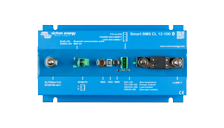
Battery Management Systems
Battery management systems take excellent care of Lithium batteries, protecting the individual cells of LiFePO4 batteries against over voltage, under voltage and over temperature and will shut down or reduce charging (VE.Bus products only) or disconnect the loads when this occurs.
Victron Energy offers several BMS options, in general the VE.Bus BMS and smallBMS signal separate devices to disconnect the charging (Inverter/Chargers, Cyrix-Li, DC-DC chargers) or disconnect the loads (BatteryProtect, Inverter/Charger), the modular Lynx distribution system features the Lynx BMS and other modules for more control over the DC busbar. For vehicles and boats all-in-one functionalities are available in the Smart BMS versions for Victron Lithium batteries, but also include current limiting to protect the alternator from overheating and BatteryProtect-like functionality to shut down the loads when pre-set critical battery conditions are met.
Victron Energy also offers full flexibility when it comes to selecting a third-party off-grid battery bank (and their BMS) of choice. A large number of well supported Lithium battery manufacturers can be easily integrated through the use of a mandatory GX-device. This flexibility enables our customers to perfectly match their off-grid needs for their unique power situation. When working with unsupported brands, a Victron Energy Battery Monitor is required to pass on accurate state of charge readings to the wider system.
Guardate tutti i nostri Sistemi di Gestione della Batteria
La scelta professionale:
Scoprite quale prodotto è più indicato per questo esempio di sistema
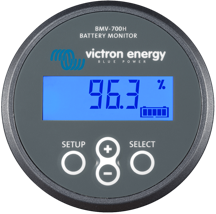
Monitor della Batteria
Il monitor della batteria è come un “indicatore di livello del carburante” della vostra batteria. Registra l’energia consumata e caricata. Il monitor della batteria calcola lo stato della carica, la capacità residua e il tempo rimanente perché la batteria si svuoti. La tensione della batteria non fornisce un’indicazione precisa del livello di carica della batteria (soprattutto se è sotto carico). Il monitor della batteria la fornisce.
I monitor della batteria di Victron Energy tengono traccia dei dati cronologici, come il numero di cicli di carica, la scarica più profonda, la tensione più alta, la tensione più bassa e così via. Avvisano delle condizioni critiche, come bassa tensione o bassa carica, e possono persino arrestare completamente l’alimentazione elettrica per evitare costosi danni alla batteria, oppure avviare un generatore.
Victron offre monitor della batteria con e senza display e versioni Smart, che consentono di tenere traccia dei dati particolareggiati e di regolare le impostazioni nella nostra app gratuita VictronConnect.
La maggior parte dei sistemi al litio richiedono un Sistema di Gestione della Batteria, che può fornire informazioni sulla batteria al sistema generale. In questa configurazione un Monitor della Batteria potrebbe essere ridondante. Vedere Sistemi di Gestione della Batteria per ulteriori informazioni. Guardate tutti i nostri Monitor della Batteria

La scelta professionale:
Scoprite quale dei nostri Monitor della Batteria è raccomandato per questo esempio di sistema
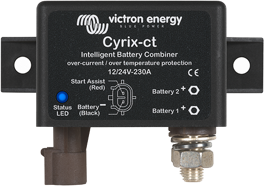
BatteryCombiner
The Cyrix BatteryCombiner is the only safe way to connect the house battery to the starter battery (to start your boat’s engines). With a BatteryCombiner you can charge the house battery from the alternator without running the risk of draining the starter battery (which always should be ready to go). When other sources of power are available (eg. shore/solar/generator power), the Cyrix BatteryCombiner will allow bi-directional charging from the house battery to the starter battery.
When the Voltages of the starter and house batteries are the same, use a Cyrix: its current rating should be equal or bigger than the current rating of the alternator. If the house battery is Lithium and the alternators Amperage is smaller than the house battery, or when the Voltages of the starter and house battery are different: use a Orion or Buck-Boost.

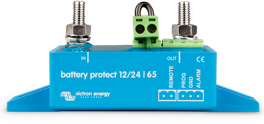
BatteryProtect
Il BatteryProtect scollega la batteria dai carichi non essenziali prima che scenda al di sotto di un livello predeterminato (una scarica completa la danneggerebbe) o prima di raggiungere un livello di carica insufficiente per l'avviamento del motore.
Ma il BatteryProtect di Victron Energy può fare molto altro. Il ritardo d’arresto integrato assicura che i componenti elettronici fondamentali non vengano scollegati per errore, ad es., quando l’avvio di un motore causa un breve calo di tensione. Inoltre, ricollega automaticamente il tutto quando la batteria raggiunge una carica sufficiente.
Il BatteryProtect è dotato di interruttore remoto, perciò può essere acceso/spento tramite un BMS o un interruttore. La versione smart è programmabile tramite la app VictronConnect.

La scelta professionale:
Scoprite quale BatteryProtect è più indicato per questo esempio di sistema
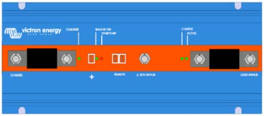
BMS 12/200
The BMS 12/200 is a dedicated battery management system (BMS) that protects Victron Smart 12,8V LFP batteries against deep discharges, overcharging and high temperatures with up to 200 Amps maximum DC current. When critical values are exceeded, the BMS acts immediately: loads are disconnected physically in case of a deep discharge and charging is stopped when there is a risk of overcharging. High temperatures trigger an immediate end to both charging and discharging.
This is the only BMS that can be directly connected to an alternator, protecting them from overload/overheating. This works with a combination of an AB fuse (rated in accordance with the expected max load current of the alternator) and an internal programmable input (which limits the input current electronically to 80% of the AB fuse).
Please check your manufacturer for the maximum charging current of your alternator and size AB fuses of the BMS 12/200 accordingly, see manual.
When different Lithium batteries & higher voltages are used, other solutions are needed, such as the VE.bus BMS and Lynx-Ion.
See our bigger boat types to see a bigger Lithium system and BMS See more info on alternator charging Lithium (and not blow them up)

Boat engines
Small motor boats rely on their engine to get the job done. Their engine comes with an alternator to charge the engine batteries, drive fuel pumps, etc.
Once the starter batteries are recharged, the engines can also recharge the house battery and power the boats electronics. When the engine is used the majority of the day, there will always be enough energy generation to compensate the daily consumption. However, when the boat isn’t used over time, batteries might run dead eventually. Our battery chargers take excellent care of your batteries when in the harbour or garage.


Boat Electronics
A small boat will have several electronic devices; they all run of the house battery. Think of:
- Boat control panel
- Log/depth sounder
- Chart-plotter or GPS
- VHF Radio
- Navigation lights
- Pump – Bilge, deck wash
- Fridge
- Interior lighting
- Music player
- Bait Tank – Recirculating
- Electric Fishing Reels/winches


Caricabatterie
Battery chargers recharge batteries (DC) when plugged into shore power (AC).
At the same time the Victron Energy battery chargers can also power devices directly.
All Victron Energy battery chargers are developed for professional duty. Our advanced multi step charging algorithms get the best out of your battery, giving the battery the power it needs, maintaining its health, ensuring better performance... and a longer life.
Smart models work with VictronConnect, so you can check the status and configure all settings of your battery charger remotely via Bluetooth. Chargers with different waterproof ratings (IP rating) are also available. Our wide range of models makes it easy to select the right charger, saving you the cost of having to buy a larger one.
Guardate tutti i nostri caricabatterie
La scelta professionale:
Scoprite quale dei nostri Monitor della Batteria è raccomandato per questo esempio di sistema
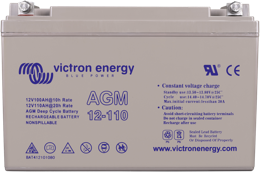
House battery
The house battery supplies power to your boat’s electrical system. Choose a battery with a generous capacity as there might be long intervals between re-charges. Sometimes the starter battery doubles up as the house battery. If you opt for this set-up, make sure the battery is well protected against discharge. It will be hard to start the boat when the battery is flat.
For a house battery you can choose from two types: lead-acid and lithium. There are various reasons to favour one over the other. Here are a few common ones:
|
|

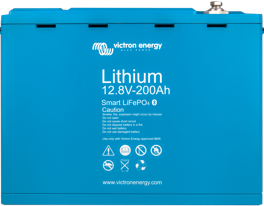
House battery
The house battery supplies power to your boat’s electrical system. Choose a battery with a generous capacity as there might be long intervals between re-charges. Sometimes the starter battery doubles up as the house battery. If you opt for this set-up, make sure the battery is well protected against discharge. It will be hard to start the boat when the battery is flat.
For a house battery you can choose from two types: lead-acid and lithium. There are various reasons to favour one over the other. Here are a few common ones:
|
|

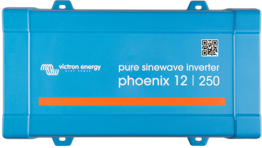
Inverter
An inverter creates AC power from a DC source. It lets you use devices on board that need a regular AC outlet.
The inverter needs to be big enough to handle the maximum AC load you want to bring on board. If the load exceeds 375 VA, you might consider a combined inverter/charger instead. Models start at 500 VA.

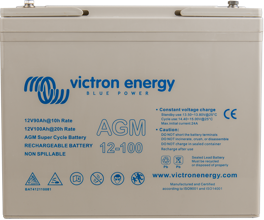
Starter Battery
The starter battery is needed to start your boat’s engine. These batteries are different from house batteries and engineered to deal with a large discharge current. The starter battery should always be ready to go. It’s best to isolate the starter battery from all other electrical circuits on board, so it cannot be accidentally drained of power, with a BatteryCombiner.

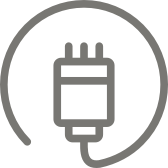
Shore Power
Either in the marina or back home you’ll hook the boats charger up to shore power to recharge the battery. Shore power can also be used for maintenance and to run large AC loads.

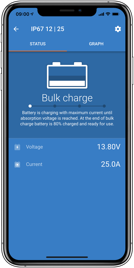
VictronConnect
All Victron products on your boat can be monitored and controlled from the palm of your hand. Just connect the VictronConnect App via Bluetooth and you’ll have direct access to indicators like battery voltage and current. You can also turn devices on or off, as well as change their settings.
See what the VictronConnect app can doIl consumo di energia varia da barca a barca e da proprietario a proprietario, anche per le piccole barche. Presentiamo due esempi di Piano Energetico Ottimale per una piccola barca, uno con un consumo quotidiano di energia normale e l’altro pesante.
Vi preghiamo di tenere presente che intervengono anche altri fattori, quando si progetta e si installa la soluzione ottimale: il vostro Professionista Victronsarà lieto di aiutarvi.
MultiPlus magic: piccolo generatore, grande potenza.
Il punto di vista di un esperto: litio o AGM a bordo?
Installate correttamente il vostro cablaggio grazie a Cablaggio Illimitato
Mostra altro
Osservate le prestazioni del vostro sistema direttamente dal Ponte di vetro.
Scoprite tutti in nostri prodotti per il Settore marittimo e altre configurazioni.
Informazioni in tempo reale e controllo completo grazie alla nostra app VictronConnect
Trovate il vostro rivenditore locale
La nostra affermata rete globale di Professionisti Victron locali si dedica ad aiutarvi a trovare la soluzione ottimale per la vostra sfida.
Affidatevi al nostro servizio mondiale
Victron considera essenziale che i clienti siano assistiti e supportati velocemente e in modo competente. Ecco perché la nostra rete globale di Professionisti Victron possiede i più alti livelli di competenze tecniche e si impegna a consegnare le riparazioni il più rapidamente possibile,
Così potrete iniziare o continuare il vostro viaggio, ovunque vi dirigiate.
